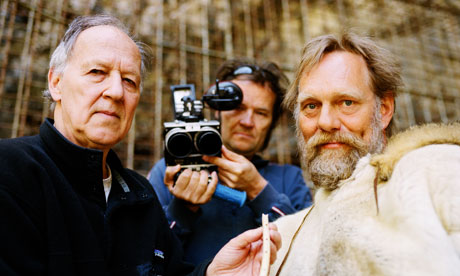
Werner Herzog has stayed the course longer than any other member of the German cinema's New Wave which burst upon the world in the early 1970s and he's been taking us to strange places in the world in the world (and even stranger ones in the mind) for 40 years. He collaborated on five films with Klaus Kinski, one of the screen's crazy men; in Heart of Glass, he hypnotised his cast before the camera rolled; he bet Errol Morris he'd eat his shoe if Morris completed his documentary Gates of Heaven and then did just that on camera; and he turns up in his own documentaries in extreme close-up, asking bizarre questions and contributing ominous commentaries. For his latest film, Herzog has had unprecedented access to the astonishing 30,000-year-old paintings that were discovered in 1994 in limestone cliffs beside the Ardèche river in southern France, in what is now called the Chauvet Cave.
It is a fascinating film, with contributions from various scientists who have studied and worked on the paintings during the brief annual periods when they're open for inspection. Herzog, who creates his own problems with a greater readiness even than Hitchcock did, decided to make things that much more difficult for his three-man crew by shooting in 3D. However, this has paid off by contributing to the audience's spatial sense of the place and to the way the animals on the wall – bison, horses, deer, rhino – appear to be in motion.
The figures, drawn over an amazing 5,000 years, often on top of each other, are breathtaking in their beauty, and seeing them in this film is as close as any of us is likely to get to them. As with Lascaux, a facsimile of the cave is to be built nearby, but however artfully constructed, such a place can only convey an impression of the real thing.
There is a price to be paid for the experience of seeing the pictures in this film. We have to put up with Herzog's heavy-breathing excitement, his wild conjecture and hyperbole, his choice of music upping the ante on the numinous, and his fey playfulness (he pops in a clip from Fred Astaire dancing to Kern's "Bojangles in Harlem" from Swing Time when referring to the effect of shadows). Sometimes it works; often it merely serves to annoy. At the point when he talks of his eerie feeling that the prehistoric artists may still be at work around the corner, I was reminded of the classic Charles Addams cartoon depicting two archaeologists examining an ancient cave painting with a flash lamp, one of them saying: "You're right. It is still wet." Lurking in the dark along the passageway is a Palaeolithic man with a querulous expression on his face.

